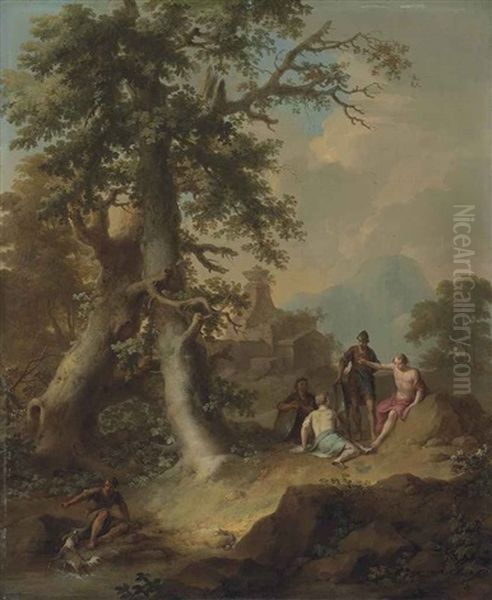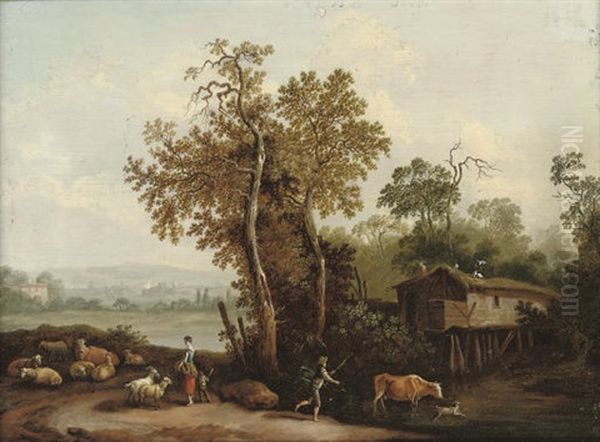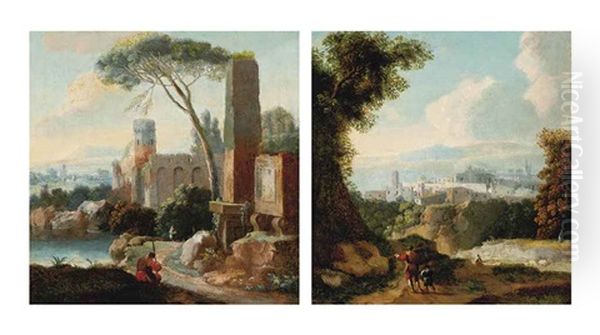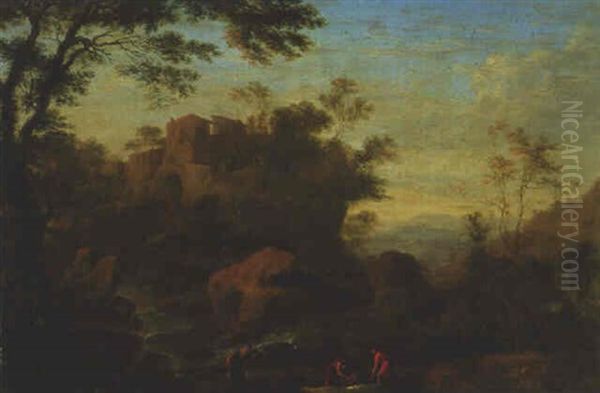Franz de Paula Ferg stands as a notable figure in the landscape and genre painting traditions of the early 18th century. An Austrian artist by birth, his career unfolded across several major European centers, absorbing and synthesizing various artistic currents. Known for his meticulously detailed small-scale works, Ferg captured the nuances of everyday life, the charm of rustic landscapes, and the evocative atmosphere of classical ruins, leaving behind a body of work admired for its refinement and technical skill, despite a life marked by travel and eventual hardship.
Early Life and Artistic Formation in Vienna
Born in Vienna on May 2, 1689, Franz de Paula Ferg entered a world rich with artistic activity. His initial exposure to art came directly from his father, Adam Pancraz Ferg, a history painter himself. This familial connection provided the young Ferg with a foundational understanding of artistic practice from an early age. Vienna, as the heart of the Habsburg Empire, was a vibrant cultural hub, offering exposure to various artistic trends.
Ferg's formal training extended beyond his father's studio. He spent a period of four years studying under a painter named Baschueber, further honing his technical abilities. Following this apprenticeship, he returned to his father's workshop but focused his attention on studying the masterful etchings of the French artists Jacques Callot and Sébastien Leclerc. The intricate details, lively figure drawing, and compositional inventiveness found in their prints profoundly influenced Ferg's developing style, particularly his handling of small figures and complex scenes.
His Viennese education continued under the guidance of Hans Graf, a landscape painter. This mentorship likely steered Ferg towards the genre that would become central to his oeuvre. He further refined his skills, particularly in landscape and the depiction of small figures within those landscapes (known as staffage), under Joseph Orient. Orient was himself a respected landscape painter in Vienna, and studying with him provided Ferg with advanced training in composition, color, and atmospheric effects specific to landscape art. The artistic environment of Vienna, with established Baroque masters like Martino Altomonte and Johann Michael Rottmayr still active, provided a rich backdrop for his development.
Travels and Development in Germany

Around 1718, Ferg decided to leave his native Vienna and embark on travels that would significantly shape his career and expose him to different artistic circles. His journey took him through various parts of Germany. He is known to have spent time in Bamberg and Leipzig. It was in Leipzig that he encountered Johann Theodor Alexander Thiele, a fellow painter specializing in landscapes.
This meeting proved fruitful. Ferg accompanied Thiele to Dresden, the capital of Saxony, which boasted a lavish court culture and attracted artists from across Europe. For a period, Ferg worked in Dresden, collaborating in some capacity with Thiele. Sources suggest that Ferg provided landscape elements or possibly figures (staffage) for Thiele's compositions. This collaboration indicates a mutual respect and shared artistic interests, likely centered on landscape depiction.
His time in Germany, particularly in Dresden under the patronage of Augustus the Strong, would have exposed Ferg to a sophisticated international art scene. Artists like the court painter Louis de Silvestre were prominent figures. This period allowed Ferg to absorb new influences and refine the elegant, detailed style that increasingly characterized his work, moving beyond purely local Viennese traditions towards a more cosmopolitan Rococo sensibility. He produced numerous works during this time, often featuring his favored themes of ruins, coastal scenes, and pastoral landscapes populated with small figures.
The London Years: Success and Hardship
Seeking further opportunities, Franz de Paula Ferg made the significant move to London around 1720. England's capital was becoming an increasingly important center for the arts and offered a potentially lucrative market for painters. Ferg integrated into the London art scene and achieved considerable success. His charming and meticulously painted works found favor with English collectors.
In London, Ferg continued to specialize in the genres he had mastered: detailed landscapes, often featuring classical ruins that appealed to the era's taste for the picturesque and the Grand Tour aesthetic; lively genre scenes depicting markets, fairs, and village life; and coastal or harbor views. His small-scale cabinet pictures, filled with intricate detail and anecdotal interest, were well-suited to the tastes of private collectors. He became a recognized figure, his work appreciated for its delicate execution and charming subject matter, holding its own in a city that would host artists like Canaletto and fostered native talents like William Hogarth and the landscape painter George Lambert.

Despite this period of success and recognition, Ferg's later years in London were marked by misfortune. Information passed down, notably through the notebooks of the engraver and antiquary George Vertue, suggests a decline into financial difficulty and personal struggles. His life ended tragically around 1740. Reports indicate he was found deceased in the street, apparently in a state of extreme poverty. While some accounts attributed his death to an accident, possibly a head injury from a falling roof tile, others hinted at despair or possible suicide linked to his impoverished circumstances. This sad end contrasts sharply with the elegance and refinement found in his art.
Artistic Style and Influences
Franz de Paula Ferg's artistic style is distinctive for its fusion of different European traditions within the framework of the emerging Rococo aesthetic. He primarily worked on a small scale, creating cabinet pictures intended for close viewing. His canvases are characterized by meticulous attention to detail, delicate brushwork, and often a cool, silvery tonality or rich, carefully modulated colors.
His subject matter frequently revolved around landscapes populated with numerous small figures engaged in various activities. These included market scenes bustling with vendors and customers, village fairs with dancers and musicians, travelers resting by the wayside, and soldiers encamped near picturesque ruins. Classical ruins, often imaginatively rendered rather than topographically exact, were a recurring motif, adding a sense of history and melancholy to his landscapes. Harbor and coastal scenes also feature in his work.
Ferg's compositions are typically well-structured and carefully balanced, often employing devices like repoussoir figures (figures placed in the foreground, often seen from behind) to enhance the sense of depth. His figures, though small, are rendered with precision and individuality, capturing gestures and interactions that bring the scenes to life.
His style reflects a synthesis of influences. The most prominent is the Dutch Italianate landscape tradition of the 17th century. Artists like Philips Wouwerman, known for his cavalry skirmishes and landscapes with horses and figures, and Herman Saftleven, famed for his panoramic river views and detailed cityscapes, were clear inspirations, particularly in the handling of light, atmosphere, and the integration of figures into the landscape. Echoes of other Dutch masters like Nicolaes Berchem or Adriaen van de Velde, specialists in pastoral scenes with animals and figures, can also be discerned.

Beyond the Dutch, the influence of Italian landscape painting, perhaps the idealized landscapes of Claude Lorrain or the more rugged scenes with ruins associated with Salvator Rosa, informed his treatment of scenery and architectural elements. Furthermore, his early study of French etchers Jacques Callot and Sébastien Leclerc remained evident in his precise drawing and lively depiction of small figures. Ferg successfully blended these diverse sources into a personal style that was elegant, refined, and aligned with the lighter, more decorative sensibilities of the Rococo era, akin in spirit, if different in subject, to the fêtes galantes of Antoine Watteau or Jean-Baptiste Pater.
Notable Works
Several specific works exemplify Franz de Paula Ferg's characteristic style and themes. Among them are pairs of paintings often conceived as pendants, showcasing his skill in composition and narrative detail within landscape settings.
Family Resting by a Fountain Ruin, with a Man on a Donkey Passing By and Family Resting by Ruins, with a Boy Struggling with a Stubborn Packhorse: This pair highlights Ferg's interest in depicting everyday life amidst evocative classical ruins. The scenes combine pastoral tranquility with anecdotal detail – the passing traveler, the struggling boy and horse. The soft lighting, detailed rendering of foliage and crumbling architecture, and the careful placement of figures are typical of his approach.
Landscape with Soldiers and Roman Soldiers Resting under Trees, Ruins in the Background: These works showcase another favorite theme: soldiers at rest in a landscape, often incorporating ruins. Ferg captures the relaxed postures and interactions of the figures, contrasting the military subject with a peaceful, picturesque setting. The attention to costume details and the atmospheric rendering of the landscape are notable.
Market Scene (dated 1722): This painting exemplifies his skill in complex genre scenes. Such works typically depict crowded marketplaces filled with vendors selling their wares, shoppers browsing, animals, and various incidental characters, all rendered with meticulous detail and lively observation. These scenes offer a vibrant glimpse into 18th-century daily life.
Harbor Scenes: Ferg also painted coastal and harbor views, often featuring ships, docks, and figures engaged in maritime activities. These works demonstrate his versatility in capturing different types of landscapes and atmospheres, from tranquil countryside to bustling ports.
Landscapes with Ruins: Many of Ferg's works prominently feature ruins, reflecting the 18th-century fascination with antiquity and the picturesque decay of classical structures. These are often imaginative compilations rather than specific locations, serving as atmospheric backdrops for his figural scenes.
These examples illustrate Ferg's consistent focus on detailed observation, skillful composition, harmonious color, and the integration of human activity within carefully rendered natural or architectural settings.
Legacy and Influence

Franz de Paula Ferg occupies a significant place in the history of Austrian and, more broadly, European Rococo landscape and genre painting. Although his peripatetic career and somewhat tragic end might have limited his long-term fame compared to court painters, his work was influential during his lifetime and beyond.
His primary contribution lies in his successful synthesis of Dutch, Italian, and French influences into a refined, elegant style perfectly suited to the tastes of the Rococo era. He helped popularize the cabinet picture format featuring detailed genre scenes within landscapes, a type of painting highly sought after by collectors in Germany and England. His work represents an important strand of Austrian landscape painting in the early 18th century, moving towards a more intimate and picturesque mode.
Ferg's influence extended to other artists. Notably, the Bohemian Rococo painter Norbert Grund is known to have been inspired by Ferg's style and subject matter. Grund's own small-scale landscapes and genre scenes share a similar delicacy and thematic focus. Furthermore, the popularity of Ferg's compositions is attested by the numerous engravings made after his paintings by various printmakers. These engravings helped to disseminate his style and imagery to a wider audience across Europe, ensuring his artistic ideas reached beyond the circle of original collectors.
While perhaps not as revolutionary as some of his contemporaries, Ferg's artistry provided a charming and technically accomplished vision of the world. He can be situated alongside other European painters who specialized in similar detailed landscape and genre scenes, such as Christian Wilhelm Ernst Dietrich (Dietricy) in Germany or Francesco Zuccarelli, an Italian painter popular in England. Ferg's work remains a testament to the cross-cultural artistic exchanges of the 18th century and the enduring appeal of meticulously crafted picturesque scenes.
Collections and Attribution
Works by Franz de Paula Ferg are found today in various public and private collections, primarily in Europe. While major museums may hold examples, a significant portion of his known oeuvre resides in private hands, particularly in Austria and Germany, reflecting his historical markets. Specific locations mentioned in records include Austrian private collections and the Solvayhall (Kalischacht) in Bernburg, Germany. His paintings also appear periodically on the art market through auctions.
As with many artists of the period, questions of attribution can sometimes arise. There has been occasional confusion between the works of Franz de Paula Ferg and those of his father, Adam Pancraz Ferg. Some sources note instances where paintings traditionally given to Franz were later reconsidered, with stylistic analysis suggesting the finer hand of his father in certain cases. This highlights the importance of careful connoisseurship in distinguishing between artists working in similar styles, even within the same family.
An interesting historical footnote concerning Ferg's works relates to the upheavals of the 20th century. A group of five paintings by Ferg was documented as having been looted by Nazi forces during World War II from a gallery in Dessau, Germany. These works were later recovered and returned to Germany thanks to the efforts of an American soldier named Oftebro, underscoring how artworks can become entangled in major historical events long after their creator's death.
Conclusion
Franz de Paula Ferg's life journey took him from the imperial capital of Vienna through the artistic centers of Germany to the bustling metropolis of London. Throughout his travels, he honed a distinctive artistic voice, specializing in finely wrought landscapes and genre scenes that captured the spirit of the Rococo age. Influenced by Dutch masters like Wouwerman, French etchers like Callot, and the broader currents of Italianate landscape painting, he created charming cabinet pictures filled with meticulous detail, delicate color, and keen observation of human life.
Despite achieving considerable success, particularly during his London years, his life ended in poverty and obscurity. Yet, the quality and appeal of his work endured. He left a mark on Austrian landscape painting and influenced subsequent artists like Norbert Grund. His paintings, found today in collections across Europe, continue to be admired for their technical refinement, imaginative compositions, and evocative portrayal of 18th-century life and landscape. Franz de Paula Ferg remains a significant, if sometimes overlooked, master of the European Rococo tradition.